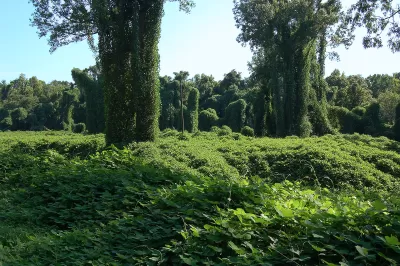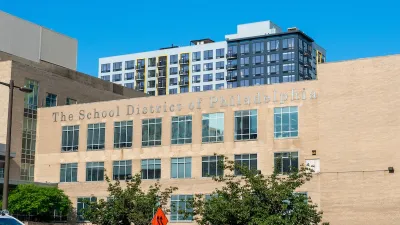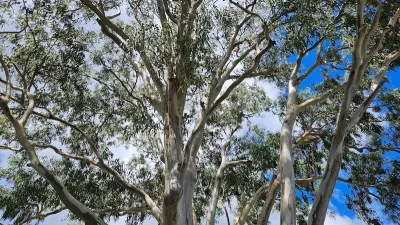Visually striking and aggressively invasive, kudzu has been choking the Southeast for decades. Now, designers, chefs, and activists want to find ways to make it useful.

Writing in Southerly Magazine, Ayurella Horn-Muller describes the influence and potential of an infamous, invasive vine known for choking Southeastern landscapes. Kudzu, a plant with "bristly, yellow-green vines and heart-shaped leaves," covers an estimated 7.4 million acres in the American Southeast and "has a reputation of being aggressively damaging to biodiversity, economies, and ecosystems." Now, writes Horn-Mueller, "after decades of being a thorn in the side of U.S. cities, rural towns, as well as the agriculture, lumber and forest product industries, kudzu’s uses are expanding — now including building materials, cooking, healing, climate action, and even cultural advocacy."
First introduced in the U.S. at the 1876 Philadelphia World's Fair, kudzu was planted decoratively and, later, to prevent soil erosion. Far from its old reputation as "Savior of the South," some are now starting to refer to it as "the vine that ate the South" due to its "ability to grow anywhere, up to a foot per day and sixty feet during the growing season."
Because it chokes the plants around it and can even impact the local nitrogen cycle in the air, kudzu contributes to ozone pollution. Economically, the damage is severe. Controlling the infestation "is already costing the forest product industry $500 per hectare per year," and an AECOM study in Oklahoma projected that the plant's spread "could result in a loss of $167.9 million" over the next five years.
"In lieu of policies to control the spread of the invasive plant, artists, chefs, and designers are finding creative ways to harvest and repurpose the plant." Designers Katie MacDonald and Kyle Schumann, founders of After Architecture, "saw [the plant's] overabundance as a possibility" to develop kudzu and other invasive plants into useful building materials. Restaurants like Kudzu Seafood Company in Macon, Georgia are experimenting with chips and other dishes made from the kudzu root, a popular edible in Japan.
"[Paulina] Harron, the researcher who led the study on the plant’s economic impact, said that these are important steps towards the bigger goal of increasing the public’s knowledge of and participation in invasive species management." While finding new uses for the plant may not mitigate the infestation issue, "using a combination of management methods is useful in controlling their populations."
FULL STORY: The role of kudzu in architecture, cuisine, and culture

Alabama: Trump Terminates Settlements for Black Communities Harmed By Raw Sewage
Trump deemed the landmark civil rights agreement “illegal DEI and environmental justice policy.”

Planetizen Federal Action Tracker
A weekly monitor of how Trump’s orders and actions are impacting planners and planning in America.

The 120 Year Old Tiny Home Villages That Sheltered San Francisco’s Earthquake Refugees
More than a century ago, San Francisco mobilized to house thousands of residents displaced by the 1906 earthquake. Could their strategy offer a model for the present?

In Both Crashes and Crime, Public Transportation is Far Safer than Driving
Contrary to popular assumptions, public transportation has far lower crash and crime rates than automobile travel. For safer communities, improve and encourage transit travel.

Report: Zoning Reforms Should Complement Nashville’s Ambitious Transit Plan
Without reform, restrictive zoning codes will limit the impact of the city’s planned transit expansion and could exclude some of the residents who depend on transit the most.

Judge Orders Release of Frozen IRA, IIJA Funding
The decision is a victory for environmental groups who charged that freezing funds for critical infrastructure and disaster response programs caused “real and irreparable harm” to communities.
Urban Design for Planners 1: Software Tools
This six-course series explores essential urban design concepts using open source software and equips planners with the tools they need to participate fully in the urban design process.
Planning for Universal Design
Learn the tools for implementing Universal Design in planning regulations.
Clanton & Associates, Inc.
Jessamine County Fiscal Court
Institute for Housing and Urban Development Studies (IHS)
City of Grandview
Harvard GSD Executive Education
Toledo-Lucas County Plan Commissions
Salt Lake City
NYU Wagner Graduate School of Public Service





























